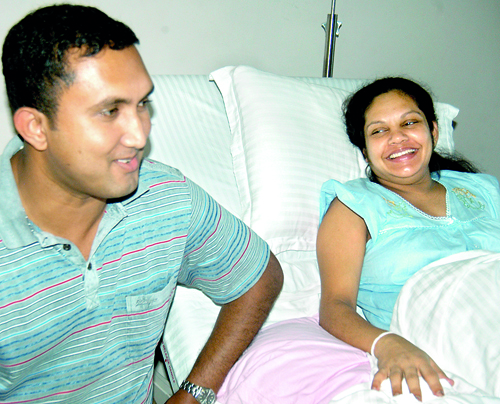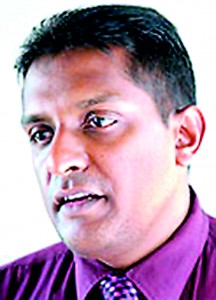1, 2, 3, 4: From antenatal labelling to safe delivery
The family is complete. It is not just father, mother and baby, but four tiny babies, all boys, in their nappies sporting different coloured fruit.
The first quadruplet birth at the private Ninewells Hospital at Narahenpita was last Sunday, August 10, complementing the 10th anniversary celebrations of the hospital.
The parents, Upuli Harshani Mallawaarachchi, 30, and Gayan Lakmal Abeyrathna, 33, are beaming when the Sunday Times meets them on Wednesday in the maternity wing on the sixth floor. The morning had been a flurry of excitement, for First Lady Shiranthi Rajapaksa herself had paid them a visit.

“Whom do they look like?” Harshani and Gayan argue jokingly. Pix by Nilan Maligaspe
“The babies, the smallest weighing 1.45kg and the biggest 1.65kg are doing fine,” says Consultant Obstetrician and Gynaecologist, Dr. Tiran Dias, who is also a Foetal Medicine Specialist who guided the pregnancy to a successful delivery and handed over the quadruplets to the care of Consultant Paediatrician Dr. Saman Kumara.
When there is a pregnancy with more than one baby, it is of paramount importance to monitor all foetuses to ensure that each and everyone is in good health, the Sunday Times learns.
‘Labelling’ or orientation of the babies while in the womb (uterus) is vital, as otherwise the Obstetrician may be examining the same baby over and over again and missing any issues with the others, leading to tragic consequences, it is understood.
Giving individual attention to each of the four babies Harshani was carrying, Dr. Dias mapped them to check out whether any one of them was facing difficulties while in the womb.
Dr. Dias certainly knows what he is talking about because “systematic labelling of twins” was first researched by him and the first scientific paper on this subject, cited around the world now, published by him. (The paper, titled ‘Systematic labelling of twin pregnancies on ultrasound’, published in ‘Ultrasound in Obstetrics and Gynaecology’ concluded that the study demonstrates that antenatal labelling of twins according to laterality or vertical orientation is reliable. The technique ensures continuity of biometric assessment from serial scans at each visit, and as such should be adopted as the preferred method of twin labelling. Furthermore, the use of orientation for antenatal labelling of twins rather than assignment of a number based on proximity to the cervix, precludes any misconception regarding which twin will be born first and ensures that parents and paediatricians are aware of the significant likelihood of a peripartum switch.)

Dr. Tiran Dias
Harshani had come to Dr. Dias in the 16th week of pregnancy. The ‘mapping’ of the babies began then, initially every four weeks followed by every two weeks. At 31 weeks, Dr. Dias detected some distress in one baby, with the blood flow to him getting weak.
All this while he had been monitoring Harshani as an outpatient, it is learnt, not getting her admitted to hospital.
“Too much bed-rest is not good,” says Dr. Dias, also pointing out that it is not advisable to put a stitch at the mouth of the cervix to prevent the mother from delivering pre-term, as is done popularly, in twin and multiple pregnancies.
Evidence-based findings are that such a stitch would increase the tendency for pre-mature labour, according to him, as when the length of the cervix becomes shorter the risks are more.
“After 30 weeks, we detected a change in one of the babies and it was then that we asked her to get admitted to hospital,” says Dr. Dias, explaining that when a Doppler indicated that the baby was having difficulties, he and Dr. Kumara decided that the time was right at 32+ weeks for the delivery.
Although there is evidence to indicate that a single baby left in the womb after 41 weeks faces the risk of death, twins face the same risk after 38 weeks and triplets after 35 weeks, he says that there is no evidence-based data when it would be ideal to deliver quadruplets.
So they delivered Harshani’s babies at 32 weeks.
“The babies were not put on the ventilator. No oxygen was given, except ‘a bit of oxygen’ to one baby. Now he too has been taken off the oxygen and is doing fine,” adds Dr. Dias.
The team headed by Dr. Dias had taken up the challenge and delivered.
| Anxious times that had a happy ending
It is the four little boys in their individual incubators in the Neonatal Intensive Care Unit (NICU) of the Ninewells Hospital whom the Sunday Times visits first. Turning from side to side the little ones are extending tiny fists into the air. Later, in the room of Harshani and Gayan, there is an air of contentment, for the new mother has just given the first feed to her boys in the NICU and returned a while before. Their life story is similar to thousands of young couples in the country. Gayan from Warakapola who had gone to Japan to study information technology and international business in 2004, had found employment there. It was in January 2011 that he married Harshani, a friend’s sister whom he had fallen in love with, taking his bride with him back to Saitama, about 90km from Tokyo from her home in Pasyala. Adept as a Kandyan dancer, she had completed a Degree in Performing Arts at the Kelaniya University. Good news came in January, this year, for the couple that Harshani was expecting but soon after they were plunged into worry. “We were told that Harshani was carrying four babies and that it was not good,” recalls Gayan, adding, “podi worry ekak thibba”. The doctors in Japan were specific – the outcome would not be good. They could select two of the best babies and abort the other two, they were told. Gayan and Harshani could not imagine making such a choice and in desperation called her brother-in-law, Dr. Geeth Weerasuriya, an Obstetrician & Gynaecologist living in Australia. “Don’t abort. Go back to Sri Lanka,” was his advice, with assurances that Sri Lanka had managed many such pregnancies successfully. With Harshani in the safe hands of Dr. Dias, Gayan had gone back to Japan, while her parents and his mother looked after her tenderly. Admitted to Ninewells Hospital on July 29, Dr. Dias and Consultant Paediatrician Dr. Saman Kumara had decided to perform a caesarian section just past 32 weeks and four days into the pregnancy. Taken into the operating theatre on Poya Day, Harshani had been given a spinal injection (anaesthetized below the waist) and along with Gayan had been very much part of the birthing process, with Dr. Dias throwing about jokes while attending to his duties. Grateful is the couple for all the support they got not only from the hospital management headed by Chairman Dr. Rohana Haththotuwa and Managing Director Chandrika Haththotuwa but also from the medical and nursing staff as well as the maternity ward staff and the NICU staff. “They will grow tall like the father, I think, for their little fingers are very long,” points out the doting mother.
|



